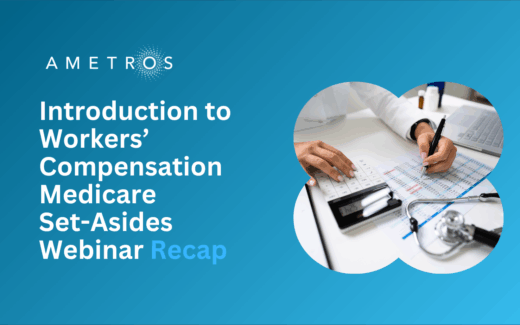On June 17, 2025, The Centers for Medicare & Medicaid Services (CMS) hosted a webinar on the Introduction to Workers’ Compensation Medicare Set-Asides (WCMSAs). The intent of the webinar was to cover the basics of WCMSAs including purpose, submission guidelines and administration, as well as to offer some WCMSA best practices. As always, we commend CMS for hosting this webinar and providing clear, accessible content for all attendees. We truly appreciate their efforts and support.
Key Takeaways:
1. CMS defines a WCMSA as settlement funds set aside for future Medicare covered medical care
2. As of July 17th, 2025, CMS will no longer accept $0 WCMSA submissions, emphasizing the need for proper planning.
What is a WCMSA and What Is Its Purpose?
A Workers’ Compensation Medicare Set-Aside Arrangement (WCMSA) is a financial agreement that allocates a portion of a workers’ compensation settlement to cover future medical expenses including prescription drugs related to the work injury. The primary purpose of a WCMSA is to protect Medicare’s interests by ensuring that funds are available to pay for future medical costs associated with a work-related injury when the injured worker is, or is expected to soon become, a Medicare beneficiary.
Under the Medicare Secondary Payer Act (42 U.S.C. § 1395y(b)(2)), Medicare is prohibited from making payments when payment has been made or can reasonably be expected to be made under a workers’ compensation plan.
CMS Guidance on WCMSAs
During the webinar, the Centers for Medicare & Medicaid Services (CMS) emphasized that the WCMSA process is voluntary:
- There is no statutory or regulatory requirement to submit a WCMSA proposal to CMS for review. However, submission is strongly recommended. The key benefit is the certainty that comes with CMS reviewing and approving the proposed amount, ensuring that Medicare’s interests are adequately protected.
- If CMS approves the WCMSA amount, Medicare will resume payments once the set-aside funds are appropriately exhausted.
- Without CMS approval, there is no guarantee that Medicare will cover future claims, and premature exhaustion of funds could result in Medicare denying payment, placing the burden on the beneficiary.
While reiterating the voluntary nature of the process, CMS expressed support for submission, noting that it provides greater protection for beneficiaries. This is especially important because the set-aside amount may not always cover all future care needs for the remainder of the beneficiary’s life.
CMS Workload Review Thresholds
WCMSA submissions are subject to the following workload review thresholds:
- The claimant is a Medicare beneficiary, and the total settlement amount exceeds $25,000.
- The claimant has a reasonable expectation of Medicare enrollment within 30 months of the settlement date, and the anticipated total settlement amount exceeds $250,000.
During the Q&A they answered a question on reasonable expectation of Medicare enrollment: How does Medicare determine if someone is likely to be enrolled in the program in the next 30 months?
The easy one is based on age; you can tell somebody's going to be Medicare entitled based on age within 30 months by month by simply doing the calculation backwards.
But the trickier one would be for entitlement based on disability filing, (this typically refers to SSDI application filing) if your disability paperwork has been filed and you're waiting for that process for approval, then if you would expect that approval within 30 months, you are considered to be a Medicare beneficiary within 30 months, and therefore the $250,000 threshold would apply. See also Section 8.1 of the WCMSA Reference Guide.
They also advised that under certain circumstances a WCMSA is not necessary:
- The injured individual is clearly being compensated for medical expenses prior to the settlement, and there is no evidence that the individual is attempting to maximize any aspects of the settlement might include lost wages or disability portions of the settlement to Medicare’s detriment.
CMS advised that they will not issue verification letters stating that a WCMSA is not necessary and that effective July 17, 2025, they will no longer accept or review WCMSA proposals with a zero-dollar ($0) allocation.
During Q&A: Does CMS envision a threshold amount for settlement to allow for a zero-dollar MSA?
As of July 17th, 2025, CMS will no longer review submissions for a zero-dollar WCMSA. This does not change any other parameters around determining whether it is appropriate for the parties to allocate zero dollars of a settlement towards future medicals. Settling parties must determine on their own, whether the parameters in section 4.2 of the WCMSA reference guide have been met.
During Q&A: What is covered by the last two years of medical records? What if no treatment in the last two calendar years?
The last two years of treatment may not be the last two calendar years. It is the last two years of treatment. Let’s say they treated last in 2022, they would then look for anything from 2020 to 2022 and it would show in the documentation, the physicians stating that this person has reached maximum medical improvement or those types of things. If there's a question or the documentation that makes them believe that there has been additional treatment, they are going to ask for those additional records. In summary, the WCMSA looks at the last two years of treatment, not just the last two calendar years.
Calculation and Funding
- Each claim is reviewed on a case-by-case basis and the amount of the WCMSA is determined on factors such as:
- Severity of injury
- Expected future medical costs
- Worker’s age
- Worker’s health status
- Funding:
- Lump Sum - the injured worker accepts a single payment intended to pay for all future medical expenses and disability benefits related to the settled work-related injury.
- Structured Settlement - In a structured WCMSA, an initial deposit is required to cover the first surgery and or procedure for each body part and or replacement and the first two years of annual payments.
After the WCRC review of a voluntary submission is complete the following will happen:
- WCRC Recommends the final amount for CMS approval
- Approval letter sent to the submitter
- Submitter sends final settlement agreement
- Medicare’s records are updated so injury-related claims are not paid.
The last bullet point results in a “W” being placed in the Common Working File to alert that a WCMSA is present.
Amended Review
- One-time request for an amended review.
- The case has not yet settled as of the date of the request for amended review.
- Projected care has changed so much that the submitter’s new proposed amount would result in a 10% or $10,000 change (whichever is greater) in CMS’ previously approved amount.
WCMSA Administration:
- Medicare beneficiaries can choose to self-administer their CMS-approved WCMSA,
- Should review the WCMSA Self-Administration Toolkit as the Toolkit describes the process and guidelines for beneficiaries managing their WCMSA account and walks them through the set-up of their WCMSA through its depletion (exhaustion) and includes helpful sample letters and other documents
- Professionally administered on their behalf
CMS discussed the basic requirements, they stated regardless of who is administering, WCMSA funds be competently administered in accordance with all Medicare coverage guidelines that include the following:
- Separate interest-bearing account
- Only be used to pay for medical services and prescription drug expenses related to the work injury.
- WCMSA funds may only be used to pay for those expenses that would normally be paid by Medicare.
- Necessary annual reporting
- Every year beginning no later than 30 days after the first-year anniversary of settlement,
- Payments were made for Medicare-covered medical expenses and Medicare-covered prescription drug expenses related to the work-related injury, illness, or disease.
CMS covered expenses can be paid by the WCMSA:
- Cost of Copying documents
- Mailing fees/postage
- Any banking fees related to the account
- Income tax on interest income from the account.
…And those that cannot be paid by the WCMSA:
- Fees for trustees, custodian, or other professionals hired to help administer the account
- Attorney costs for establishing the MSA
- Medicare premiums, co-payments, and deductibles.
During Q&A: For an MSA, if you settle with a lump sum MSA and not an annuity, can it be professionally administered?
Yes, it does not make a difference, whether it is a lump sum or if it is an annuity, you can use professional administration.
The WCMSA webinar highlighted the growing importance of proper professional administration in the ever changing WCMSA landscape. From meeting CMS requirements to ensuring accurate reporting and fund management, everything discussed in this webinar reinforces the value of the work that Ametros is doing for its members. As always. WCMS strongly recommends the use of a professional administration to ensure compliance, protect injured workers, and streamline the settlement process.
If you have any questions about how Ametros simplifies and supports MSA administration and other future medical allocations post-settlement, don’t hesitate to get in touch with us.


